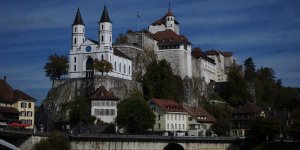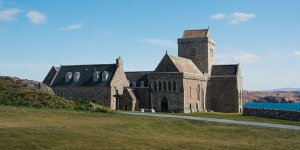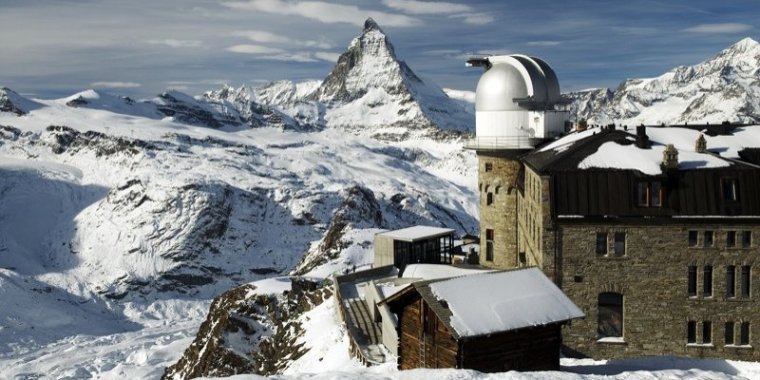| Travel / Tourist Attractions |
Matterhorn (Mont Cervin, Monte Cervino) Switzerland
The Matterhorn is a mountain of the Alps, straddling the main watershed and border between Switzerland and Italy. It is a large, near-symmetrical pyramidal peak in the extended Monte Rosa area of the Pennine Alps, whose summit is 4,478 metres (14,692 ft) high, making it one of the highest summits in the Alps and Europe. The four steep faces, rising above the surrounding glaciers, face the four compass points and are split by the Hörnli, Furggen, Leone/Lion, and Zmutt ridges.
The mountain overlooks the Swiss town of Zermatt, in the canton of Valais, to the north-east and the Italian town of Breuil-Cervinia in the Aosta Valley to the south. Just east of the Matterhorn is Theodul Pass, the main passage between the two valleys on its north and south sides, and a trade route since the Roman Era.
The Matterhorn is also named Gran Bèca by the Valdôtains and Horu by the local Walliser German speaking people.
The Matterhorn's faces are steep, and only small patches of snow and ice cling to them; regular avalanches send the snow down to accumulate on the glaciers at the base of each face, the largest of which is the Zmutt Glacier to the west. The Hörnli ridge of the northeast (the central ridge in the view from Zermatt) is the usual climbing route.
The Matterhorn was one of the last of the main Alpine mountains to be ascended, not because of its technical difficulty, but because of the fear it inspired in early mountaineers. The first serious attempts began around 1857, mostly from the Italian side; but despite appearances, the southern routes are harder, and parties repeatedly found themselves having to turn back.
The first ascent of the Matterhorn was finally made in 1865 from Zermatt by a party led by Edward Whymper which ended disastrously when four of its members fell to their deaths on the descent.
Sometimes referred to as the Mountain of Mountains (German: Berg der Berge), the Matterhorn has become an iconic emblem of the Swiss Alps and of the Alps in general.
The town of Zermatt remains almost completely free of internal combustion vehicles and can be reached by train only. (Apart from the local police service which uses a Volkswagen car, only electric vehicles are used locally).
The Gornergrat railway, reaching a record altitude of 3,100 metres, was inaugurated in 1898. Areas served by cable car are the Unterrothorn and the Klein Matterhorn (Little Matterhorn) (3,883 m, highest transportation system in Europe). The Hörnli Hut (3,260 m), which is the start of the normal route via the Hörnli ridge, is easily accessible from Schwarzsee (2,600 m) and is also frequented by hikers. The Zermatt and Breuil-Cervinia resorts function as separate ski resort all year round and are connected by skilifts over the Theodul Pass.
The Matterhorn Museum (Zermatt) relates the general history of the region from alpinism to tourism. In the museum, which is in the form of a reconstituted mountain village, the visitors can relive the first and tragic ascent of the Matterhorn and see the objects having belonged to the protagonists.
The Tour of the Matterhorn can be effected by trekkers in about 10 days. Considered by some as one of the most beautiful treks in the Alps, it follows many ancient trails that have linked the Swiss and Italian valleys for centuries.
The circuit includes alpine meadows, balcony trails, larch forests and glacial crossings. It connects six valleys embracing three different cultures: the German-speaking high Valais, the French-speaking central Valais and the bilingual French/Italian-speaking Aosta Valley. Good conditions are necessary to circumnavigate the peak.
After reaching Zinal from Zermatt by the Augstbord and Meiden passes, the trekker crosses the Col de Sorebois and the Col de Torrent before arriving at Arolla. Then the Arolla Glacier and the Col Collon must be crossed on the way to Prarayer, followed by the Col de Valcournera to Breuil-Cervinia.
In the last and highest section, the Theodul Pass must be crossed before returning to Zermatt. In total, seven passes between 2,800 and 3,300 metres must be crossed on a relatively difficult terrain.
Sources
• www.wikipedia.org
• www.wikivoyage.org
YOU MAY ALSO LIKE









